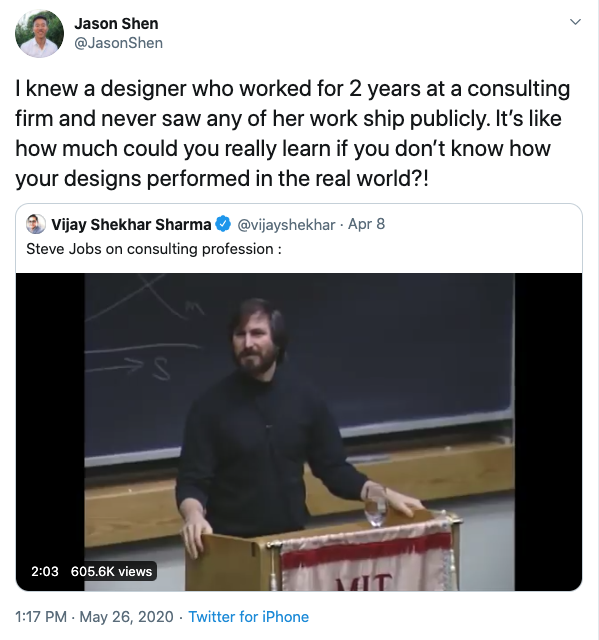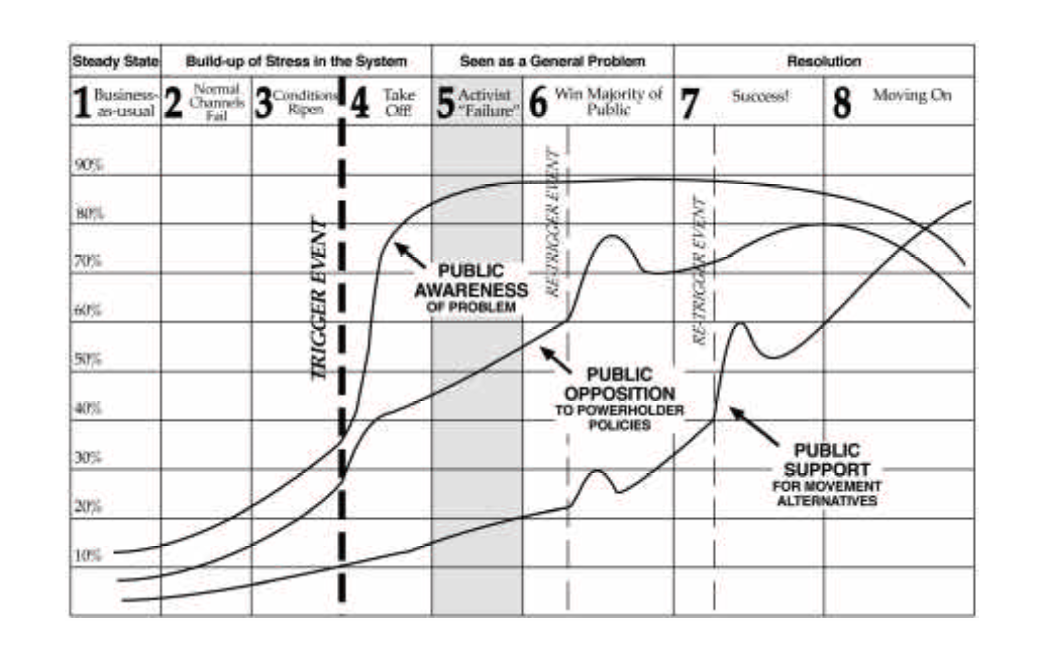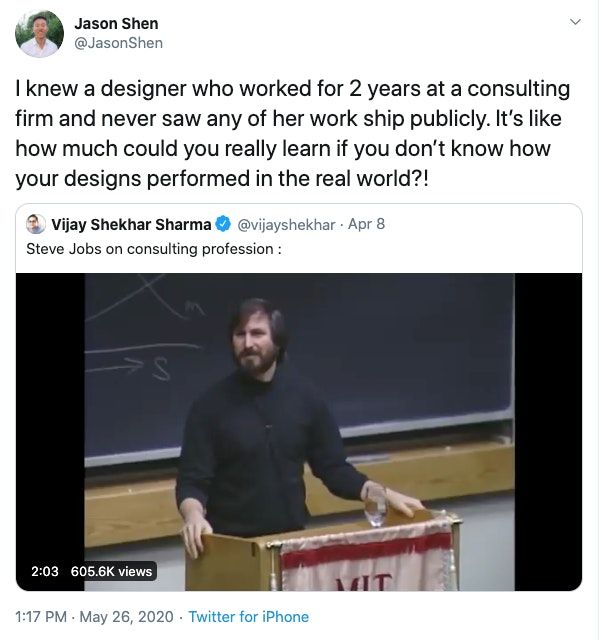Hey friends,
Welcome back the 4th edition of Making Connections, where we take a random walk down tech, fitness, product thinking, org design, nerd culture, persuasion, and behavior change.
Today we’re talking about what opportunity looks like, learning by shipping & the arc of social progress
1. Knowing the shape of your ideal opportunity
Strategy | Patterns | Coaching
You may recall from MC#003 that I was doing some birthday coaching. One of the ideas that came out of my coaching sessions from Monday was this idea:
"What does a great opportunity look like?"
This question came up in both an example of a job search and in the hunt for a great real estate investment. In both situations, the person was thinking about the things they need to do to get the opportunity, or worrying about the risks of taking the opportunity. But they had not clearly articulated to themselves what that great opportunity looked like.
It made me think of something Warren Buffett offers to business school students:
When Warren lectures at business schools, he says, “I could improve your ultimate financial welfare by giving you a ticket with only 20 slots in it so that you had 20 punches—representing all the investments that you got to make in a lifetime. And once you’d punched through the card, you couldn’t make any more investments at all.”
He says, “Under those rules, you’d really think carefully about what you did and you’d be forced to load up on what you’d really thought about. So you’d do so much better.”
Relayed by Charlie Munger, Buffett's partner (via jamesclear.com)
In both cases, I asked the person to write down a list of criteria for what would constitute a really great job opportunity or the perfect real estate deal. You could apply the same idea to a romantic partner, an ideal customer, or the perfect startup investment.
Whether you’re considering a lot of opportunities or just a few, knowing what really matters to you and what you're aiming for beforehand helps you avoid talking yourself into something that's suboptimal, or missing out on something great.
2. How much can you really learn without shipping?
Tech | Learning
There can be times though, when too much research and thinking (and not enough doing) can be an issue.
In 1992, Steve Jobs gave a talk at MIT (the entire video is on YouTube and it's awesome - article recap). He was running NeXT Computer after being fired from Apple. He was no longer the brash young rebel leader. He had a beard and long hair and spoke at length on computing, management, and careers without any notes or slides. He cracks some jokes too.
On the value of being a consultant
Someone posted a clip on Twitter where he talks about the value of being consultant as a profession. Doing research and writing up reports and recommendations without actually working deeply in an area.
“I think that without owning something over an extended period of time, like a few years, where someone has a chance to take responsibility for one’s recommendations, where one has to see one’s recommendations through all action stages and accumulate some scar tissue for the mistakes and pick one’s self up off the ground and dust one’s self off, one learns a fraction of what one can. You do get a broad cut at companies, but it’s very thin.”
Jobs is underscoring the importance of shipping and the valuable lessons from doing the work that cannot be gained any other way. That made me think of a designer I knew:

Learning from experts vs action
My designer friend certainly improved in fundamentals based on critiques from her manager and other designers at the firm, but none of them will really be able to see if the designs "really work" with actual users.
If you are learning to run a design firm, maybe that doesn't matter. Maybe all you need to learn is how to land clients and keep them coming back. But if you are trying to create for the real world, you can't rely on research or experts. You have to put your work into the world and see how people respond.
Because one of the few, most unpredictable things about people is how they choose to spend their attention and money. Despite lots of data and lots of smart people out there, products, services, games, movies, etc flop all the time. So you learn to try lots of things (more on product iteration in MC#002)
Shipping in the real world is humbling, but it's a great teacher.
3. What is the arc of social progress?
Progress | Race | Culture
As I write this, there are protests and clashes between citizens and police officers are happening in cities all over the United States. People are angry at seeing yet another black man murdered in broad daylight while begging to for air and his life by a uniformed officer. They're angry seeing a white woman threaten black man's life through a false 911 call. Angry at an incompetent and heartless government response to a global pandemic.
Responding to an infection
When you are infected with a disease like the flu, your body raises its temperature and triggers a fever. It feels awful. Fevers force you to rest, allowing your body to fight the infection and heal.
For a society, protests and riots are the fever. Racism and xenophobia are the disease. Any damage or harm to person and property is awful. But the civil unrest we're experiencing is important and will continue until we take meaningful actions to address the disease.
How movements work
My friend Tony shared this paper with me: the Movement Action Plan. Originally published in 1986 and updated in the mid 90's by Bill Moyer, an organizer who worked on MLK's staff, the ideas hold up very well today.

One key insight is that social movements actually require 3 key stages:
- Public awareness of the problem passes 80%
- Public opposition to the policies and power structures that are causing the problem passes 50%
- Public support for the movements alternate solutions passes 50%
With the #BlackLivesMatter movement, I think we've probably reached 1, but we're not yet at 2. Moyer explicitly points out that it's easy for activists to get demoralized at their perceived "failure" to achieve results, when really it's because the process has multiple steps and it can be hard to see where you are.
None of that brings back the lives of those killed or unjustly incarcerated but hopefully it is food for thought as we continue on in this time of pain and anger. We’re starting to fully recognize the problem, but which policies and power structures are we prepared to oppose?
And that’s it for edition #004 for Making Connections. Thanks for joining this band of curious readers. Would love to hear your thoughts (just reply or click the comment button to start a conversation!)
Yours in solidarity,
Jason

